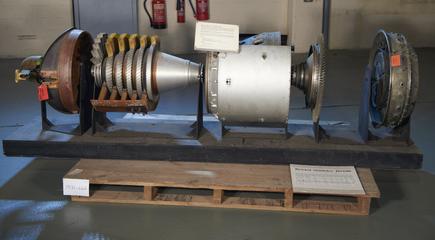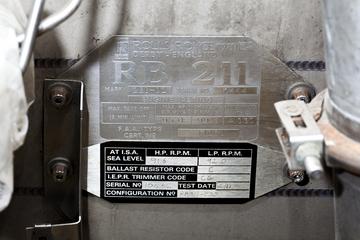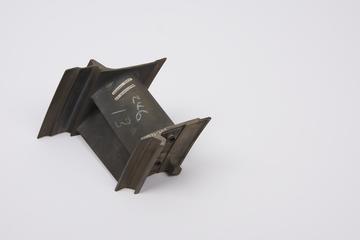




Derwent V aircraft engine, made by Rolls-Royce Limited, Barnoldswick, c.1946.
The Rolls Royce Derwent was an early type of jet engine.
In the 1930s the engineer Frank Whittle had invented the earliest practical turbojet engines, which were used in Britain’s first jet aircraft in the 1940s. The Rolls-Royce Derwent was a further development of Whittle’s earlier jet designs and the first prototype ran in 1943. Like most of Rolls-Royce’s jet engines it is named after a British river. The Derwent’s main use was in the Gloster Meteor, Britain’s first jet fighter aeroplane.
Rather than burning fuel in one large combustion chamber like most modern jet engines, Whittle’s designs used a ring of small combustion chambers around the outside of the engine, with a large centrifugal fan in the centre to compress the air that fed into them. This made the engines wider and shorter than was typical in many other later designs.
The basic Derwent design was further developed into the larger and more powerful Nene jet engine. The Nene design was then scaled down to produce the Mark V version of the Derwent, like this one. Most Derwent Mark V’s were made by Rolls Royce in Derby, but this example is thought to be have been made in Barnoldswick, Lancashire, which may make it one of the earlier examples.
Details
- Category:
- Aircraft Propulsion
- Object Number:
- Y1969.24
- Materials:
- metal (unknown), paint, rubber (unidentified) and plastic (unidentified)
- Measurements:
-
overall: 1630 mm x 2150 mm x 1260 mm, 881 kg
overall (estimate): 910 mm x 1140 mm x 1980 mm,
- type:
- aircraft engine
- credit:
- Gift of University of Manchester Institute of Science and Technology, Mechanical Engineering




